Bulletin – December 2013 Finance Developments in Foreign Exchange and OTC Derivatives Markets
- Download the article 477KB
Abstract
Global activity in foreign exchange and over-the-counter (OTC) derivatives markets continued to increase over the three years to April 2013. The increase in foreign exchange turnover was mostly driven by growth in the United Kingdom. Turnover in Australia declined slightly, even though global turnover of the Australian dollar increased markedly. Globally, the notional amount of OTC derivatives outstanding increased modestly over the three years to the end of June 2013, while the increase was more pronounced in the Australian market.
Background
The 2013 Triennial Central Bank Survey of Foreign Exchange and OTC Derivatives Markets Activity (Triennial Survey) provides a comprehensive and unique source of information about the activity and structure of these markets.[1] The 2013 Triennial Survey was conducted in two parts: the turnover portion of the survey measured activity in foreign exchange and single-currency interest rate derivatives markets in the month of April, while the outstandings portion of the survey measured the amount of OTC derivatives outstanding as at the end of June.
This article discusses the key results from the survey on foreign exchange turnover and examines some of the broad drivers of foreign exchange market activity both globally and in Australia. It also provides an overview of developments in the size of OTC derivatives markets as measured by the amounts outstanding.[2]
Foreign Exchange Turnover
Global foreign exchange turnover grew by 35 per cent over the three years to April 2013, to reach an average of US$5.3 trillion per day (Graph 1).[3] The rate of growth exceeded that over the previous three years and coincided with a 25 per cent increase in the value of international trade over the same period. In contrast, global cross-border lending and investment, which are also key sources of transaction demand for foreign exchange, have been little changed over the three-year period (Graph 2). Part of the growth in global turnover over the measured three-year period appears to have reflected increased short-term trading activity that took place in the month of April, when the survey was conducted, primarily in response to the decision by the Bank of Japan (BoJ) to substantially expand its asset purchase program. This announcement triggered a large increase in volatility – and turnover – in the Japanese yen, with the growth in turnover most noticeable in the United Kingdom and between ‘reporting dealers’ and ‘other financial institutions’.[4]
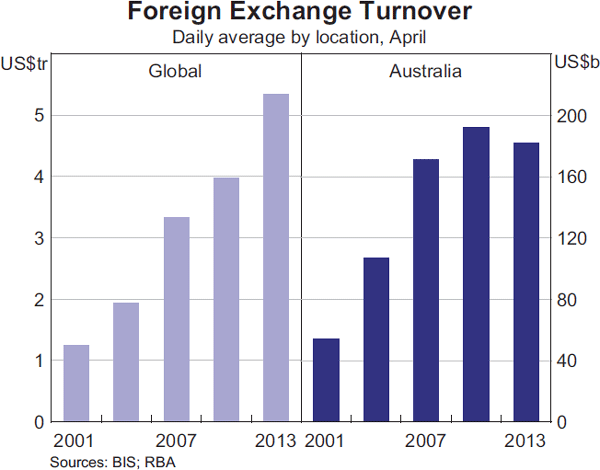
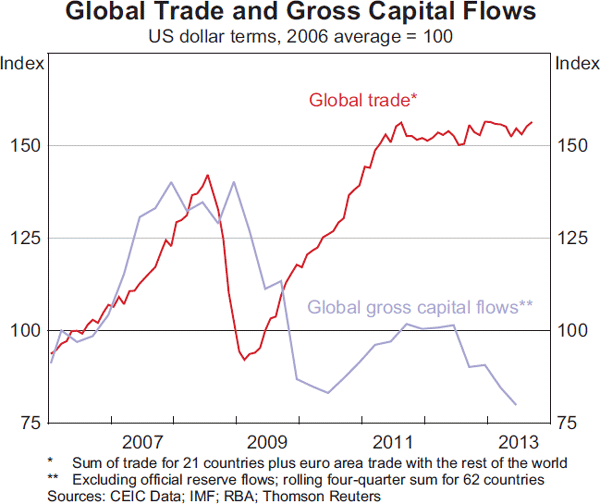
In contrast to the strong growth recorded globally, turnover in the Australian foreign exchange market declined by 5 per cent over the three-year period to an average of US$182 billion per day, primarily reflecting a significant decline in turnover in the euro.[5] In the Australian market, turnover in the Japanese yen and the Australian dollar increased by much less than the global rate of growth and only partially offset the decline in euro turnover. Given the volatility in foreign exchange markets around the time of the survey, the relatively modest increases in turnover in the Australian dollar and Japanese yen in Australia could be partly explained by the fact that hedge funds and proprietary trading firms have a smaller presence in the domestic market compared with other major financial centres, particularly the United Kingdom.
Turnover by jurisdiction
The global foreign exchange market became more geographically concentrated over the three years to April 2013, with the United Kingdom's position as the largest centre further reinforced by a 4 percentage point increase in its market share, to just over 40 per cent (Table 1, Graph 3). As the major global foreign exchange centre, and the market with the greatest liquidity, the United Kingdom has a relatively high concentration of market participants that tend to be associated with speculative and/or high-frequency trading activity – including hedge funds and proprietary trading firms. As such, the marked increase in turnover in the United Kingdom appears to be partly the result of increased speculative activity in April in response to the BoJ policy announcement. However, it is also consistent with the longer-term trend towards an increased share of global activity in London: the United Kingdom's market share has increased by 9 percentage points since the 2004 survey.
| Market share | ||||
|---|---|---|---|---|
| Daily average, April 2013 |
Change over 2010−2013 |
April 2010 | April 2013 | |
| US$ billion | Per cent | Per cent | Per cent | |
| Total | 5,345 | 35 | na | na |
| United Kingdom | 2,726 | 47 | 36.8 | 40.9 |
| United States | 1,263 | 40 | 17.9 | 18.9 |
| Singapore | 383 | 44 | 5.3 | 5.7 |
| Japan | 374 | 20 | 6.2 | 5.6 |
| Hong Kong | 275 | 16 | 4.7 | 4.1 |
| Switzerland | 216 | −13 | 4.9 | 3.2 |
| France | 190 | 25 | 3.0 | 2.8 |
| Australia | 182 | −5 | 3.8 | 2.7 |
| Other countries | 1,063 | 21 | 17.4 | 15.9 |
|
(a) The sum of the country subtotals exceeds the global total as country subtotals are not adjusted for cross-border double counting Source: BIS |
||||
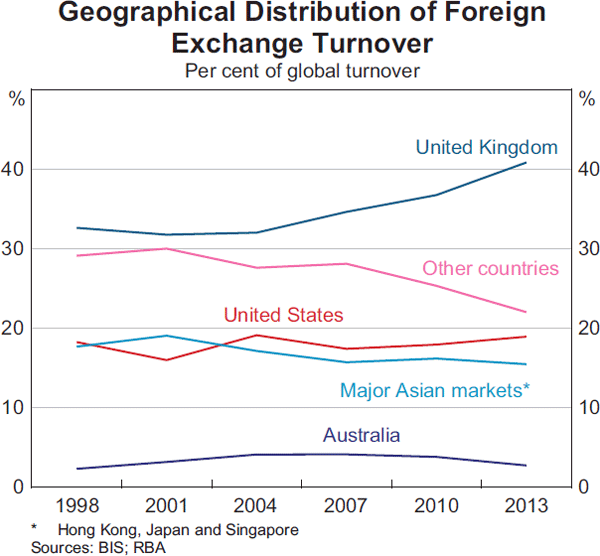
The United States remained the second largest centre, followed by Singapore, Japan and Hong Kong. Collectively, these four markets accounted for a little less than 35 per cent of global turnover, which is little changed from the 2010 survey. In contrast, smaller markets tended to lose market share over the three-year period, continuing a trend that has been evident since 2007. Within this group of smaller markets, Switzerland and Australia recorded the largest declines in market share over the three years to April 2013.
The share of cross-border transactions fell to 58 per cent of global turnover in April 2013, down from 65 per cent in April 2010. This is the lowest proportion of cross-border activity since 2001 and is consistent with the increased geographical concentration of the global foreign exchange market. The decline could also reflect a reduction in cross-border lending and investment by banks in some large regions (e.g. the United Kingdom and Europe). The share of cross-border transactions is higher in smaller financial centres – including Australia at 75 per cent – although the share reported by Australian dealers also declined over the three-year period (from almost 80 per cent in 2010).
Turnover by currency
The earlier expectation and subsequent announcement of a change in policy by the BoJ in April 2013 contributed to a 63 per cent increase in global turnover in the Japanese yen over the three years to April 2013 (Table 2). The increase was concentrated in the USD/JPY currency pair, with turnover in this pair increasing by 72 per cent over the three-year period. Evidence from semiannual surveys conducted in six of the largest foreign exchange markets indicates that a significant part of the increase occurred in the six months leading up to April 2013.[6]
| Global | Australia | |||
|---|---|---|---|---|
| Daily average, April 2013 |
Change over 2010−2013 |
Daily average, April 2013 |
Change over 2010−2013 |
|
| US$ billion | Per cent | US$ billion | Per cent | |
| Total | 5,345 | 35 | 182 | −5 |
| Currency(a) | ||||
| USD | 4,652 | 38 | 164 | −5 |
| EUR | 1,786 | 15 | 27 | −43 |
| JPY | 1,231 | 63 | 26 | 4 |
| GBP | 631 | 23 | 13 | −26 |
| AUD | 462 | 53 | 91 | 6 |
| Other currencies | 1,927 | 34 | 42 | 20 |
| Currency pair | ||||
| EUR/USD | 1,289 | 17 | 21 | −46 |
| USD/JPY | 978 | 72 | 21 | 11 |
| GBP/USD | 472 | 31 | 9 | −36 |
| AUD/USD | 364 | 46 | 81 | 7 |
| USD/CAD | 200 | 10 | 4 | −7 |
| Other currency pairs | 2,043 | 35 | 47 | 13 |
|
(a) The sum of the currency subtotals is divided by two as each transaction involves two currencies Source: BIS |
||||
The exceptionally strong growth in global turnover in the USD/JPY currency pair also partly explains an almost 40 per cent increase in US dollar turnover over the period. However, the growth in US dollar turnover also reflects strong increases in turnover of a number of emerging market currencies – most notably, the Chinese renminbi (RMB) and Mexican peso – as these currencies tend to be more heavily traded against the US dollar than they are against the euro or Japanese yen (discussed below). The US dollar remains by far the most traded (and liquid) global currency and is now included in one side of 87 per cent of all transactions. The large share of US dollar activity reflects the US dollar's role as the primary global reserve currency and, relatedly, the fact that a large proportion of financial products and trade contracts are denominated in US dollars.
In contrast, the share of transactions that included the euro declined by 6 percentage points to 33 per cent over the three years to April 2013. Uncertainty surrounding the Greek sovereign debt crisis may have bolstered euro turnover at the time of the 2010 survey, with the subsequent decline in the euro's share of total turnover consistent with the more benign political environment in Europe more recently. In addition, the banking and fiscal problems in the euro area have been accompanied by a general reduction in cross-border investment and business lending activity by European residents, which is likely to have weighed on euro turnover over the period. In the Australian market, a sharp decline in turnover in the EUR/USD currency pair contributed to a decline in overall turnover.
Global turnover in the Australian dollar increased by 53 per cent over the three years to April 2013, and reflects growth of 84 per cent in the United Kingdom and 34 per cent on average in other jurisdictions. Overall, 84 per cent of global turnover in the Australian dollar now occurs outside of Australia (compared with around 60 per cent in 2001). This is broadly consistent with the share of offshore turnover in other globally traded currencies (including the New Zealand dollar, Canadian dollar, Swiss franc and Japanese yen). Almost 40 per cent of Australian dollar turnover occurred in the United Kingdom in April 2013, which represents an increase of 7 percentage points from April 2010 (Graph 4). As discussed, the UK market tends to have a higher share of hedge funds and proprietary trading firms and after the Australian dollar reached its multi-year high in early April 2013, the subsequent depreciation over the rest of the month may have led to increased activity from these types of investors as they positioned their portfolios based on an expectation of a depreciation of the Australian dollar in the future.
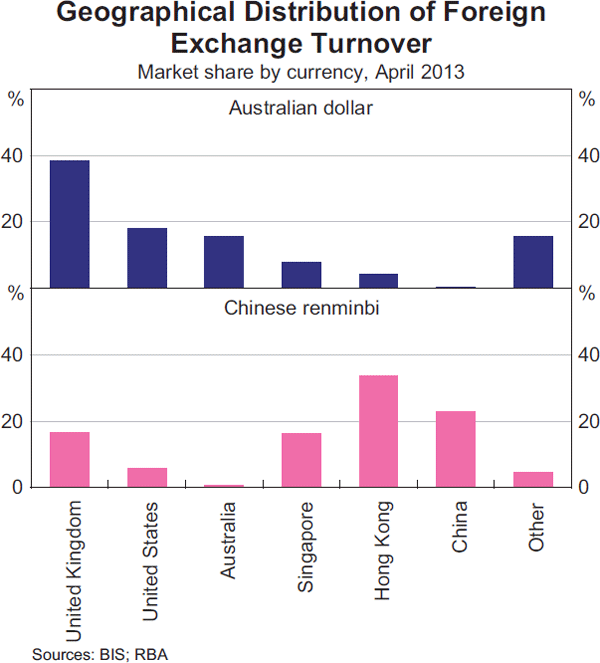
Turnover of some emerging market currencies also increased significantly over the three years to April 2013, consistent with broader economic and financial market development in some of these countries. However, improved data collection may also have contributed to these gains. The Mexican peso is now the eighth most traded currency globally after turnover increased by around 170 per cent over the past three years, and the RMB is now the ninth most traded after turnover increased by 250 per cent.
The increase in RMB activity is consistent with China's ongoing progress in internationalising the RMB.[7] In April 2013, around 45 per cent of RMB turnover was recorded outside of Hong Kong and China and this could be expected to increase over coming years as other financial centres develop into RMB trading hubs and the use of RMB becomes more widely accepted – for example, as an invoicing currency for trade.
Turnover by counterparty
Reporting dealers in each jurisdiction provide information on their turnover with other reporting dealers (which makes up the interdealer market), with other financial institutions, and with non-financial institutions. Much of the increase in global turnover over the three-year period was driven by increased activity between reporting dealers and other financial institutions, including non-reporting banks, institutional investors, hedge funds and proprietary trading firms, as well as official sector institutions (such as central banks and sovereign wealth funds; Table 3). This is in contrast to the Australian market, where turnover between reporting dealers and other financial institutions was reported to have declined over the three-year period (Graph 5).[8]
| Global | Australia | |||
|---|---|---|---|---|
| Daily average, April 2013 |
Change over 2010−2013 |
Daily average, April 2013 |
Change over 2010−2013 |
|
| US$ billion | Per cent | US$ billion | Per cent | |
| Reporting dealers | 2,070 | 34 | 127 | 8 |
| Other financial institutions | 2,809 | 48 | 43 | −29 |
| Non-reporting banks | 1,278 | na | 19 | na |
| Institutional investors | 603 | na | 10 | na |
| Hedge funds, proprietary trading firms | 576 | na | 2 | na |
| Official sector financial institutions | 53 | na | 1 | na |
| Other/undistributed | 300 | na | 11 | na |
| Non-financial institutions | 465 | −13 | 11 | −17 |
|
(a) All amounts represent transactions between reporting dealers and each counterparty type; transactions with other reporting dealers are often referred to as ‘interdealer’ transactions; a detailed breakdown of other financial institutions is not available for 2010 Source: BIS |
||||
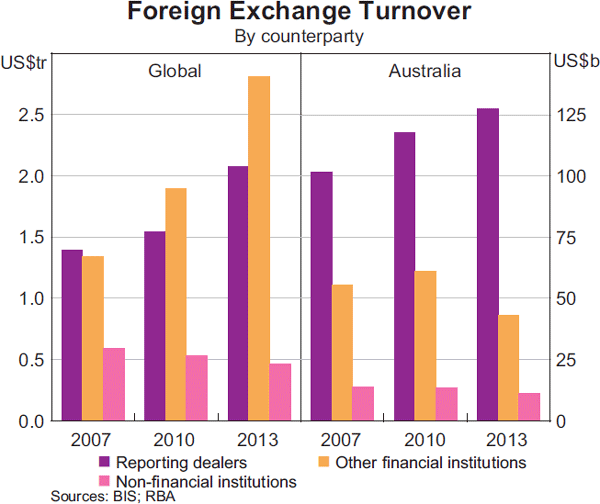
A more detailed counterparty breakdown of the other financial institutions category was collected for the first time in 2013. The data reveal that, globally, non-reporting banks accounted for around 45 per cent of this sector's turnover with reporting dealers in April 2013, with institutional investors (e.g. pension funds) and hedge funds and proprietary trading firms together accounting for around 42 per cent. Given that some of these entities are likely to have been especially active in the period leading up to and following the BoJ policy announcement, it is possible that the April 2013 data overstates the usual market shares of these institutions. However, the growth in turnover between reporting dealers and other financial institutions could also reflect a continued increase in the use of electronic trading methods, including algorithmic and high-frequency trading by these institutions. This is also consistent with the marked increase in turnover in the major trading centres, as algorithmic trading styles tend to be more prevalent in markets with greater liquidity and where execution delays are at a minimum (due to their proximity to the electronic platforms of ‘market makers’ executing the trades).[9]
The strong global growth in turnover between reporting dealers and other financial institutions over the three years to April 2013 was partly offset by a 13 per cent decline in turnover between reporting dealers and non-financial institutions. The decline in turnover with non-financial institutions was also evident in Australia, with this market segment now accounting for less than 10 per cent of turnover in both the domestic and global markets (compared with a global average of 15 per cent over the past five surveys). This is despite the 25 per cent increase in global trade over the three-year period, which is likely to be a key source of foreign exchange demand for non-financial institutions. The divergent outcomes for global trade and foreign exchange turnover with non-financial institutions could in part reflect ongoing changes to how non-financial institutions manage their foreign currency exposures. These could include a reduced need for hedging products due to an increased use of ‘natural hedging’ – for example, as global supply chains have become more integrated – and a possible reduction in the extent to which multinational firms choose to repatriate their foreign currency receipts.[10]
Turnover between reporting dealers (i.e. in the interdealer market) increased in line with total global turnover over the three-year period, continuing to account for around 40 per cent of global turnover. In contrast, turnover between reporting dealers in Australia accounts for a much larger share of the local market (at around 70 per cent) and turnover between reporting dealers increased by 8 per cent over the three-year period.
The level of turnover between reporting dealers can be influenced by transactions between reporting dealers and other financial institutions, and between reporting dealers and non-financial institutions. This is because reporting dealers may enter into offsetting transactions with other reporting dealers in order to reduce the exchange rate risk that would otherwise be associated with being a counterparty to these transactions. In addition, some customers (generally classified as other financial institutions) make use of a prime brokerage relationship whereby they transact in the market, subject to credit limits, under the reporting dealer's (or prime broker's) name with a group of predetermined third-party banks. This prime brokerage turnover, which accounts for 16 per cent of global turnover but only 2 per cent of Australian activity, is recorded in the survey as two transactions: one between the reporting dealer (prime broker) and the customer, and one between the reporting dealer and the counterparty dealer.
More generally, technological advances have influenced the way that reporting dealers manage the risk that arises from customer transactions. Over time, the subsequent turnover generated by each customer trade has probably fallen as technology has allowed reporting dealers to internalise these transactions more effectively. That is, they can match off transactions within their own institution without the need to trade with other reporting dealers, which would otherwise incur transaction costs.[11]
The recent survey also provided data on the share of turnover classified as ‘retail-driven’ and the type of execution method (by voice or electronically). Retail-driven transactions accounted for around 3 per cent of global turnover but are a relatively small part of the Australian market, at less than ½ per cent of turnover. Around 55 per cent of transactions globally were transacted via electronic methods compared with around 62 per cent for the Australian market.
Turnover by instrument
Global turnover increased across all types of foreign exchange instruments over the three years to April 2013, with foreign exchange (FX) swaps and spot transactions each continuing to account for around 40 per cent of total foreign exchange market activity (Graph 6).
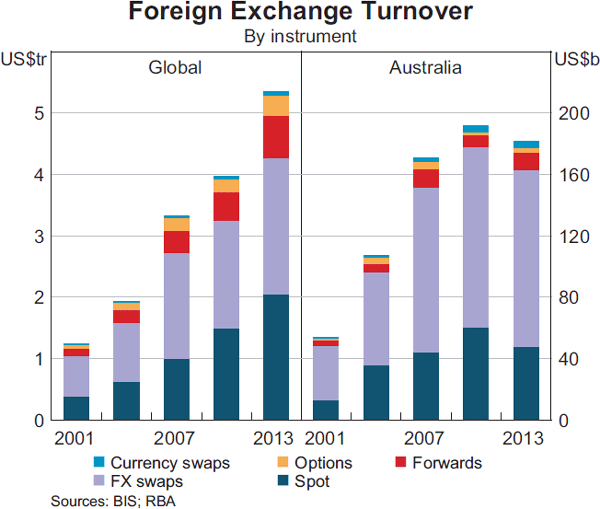
In contrast to the global results, Australian turnover in both FX swaps and spot transactions declined over the three-year period. Nevertheless, turnover in FX swaps remained well above the average of the past decade and these transactions continued to account for a relatively high share of the Australian market, at around 63 per cent. Spot turnover in Australia also remained above the average of the past decade. The slight reduction in the use of FX swaps could reflect a change in hedging policy by Australian asset managers – which use FX swaps to hedge against the foreign exchange risk inherent in their holdings of foreign assets – particularly given the high level of the Australian dollar at the time of the survey.[12] Consistent with this, FX swap turnover with other financial institutions fell by 21 per cent over the three-year period, compared with a 2 per cent decline in FX swap turnover in the Australian market as a whole. In addition, a fall in demand for short-term foreign currency borrowing by Australian banks may have also contributed to reduced demand for FX swaps.
Meanwhile, turnover in cross-currency swaps was little changed over the three-year period. Australian financial institutions typically use cross-currency swaps to hedge the foreign exchange exposures associated with borrowing from global capital markets and, as a consequence, Australia accounts for a relatively high share of the global cross-currency swap market (around 7 per cent of turnover in April 2013, compared with 3 per cent of overall foreign exchange market turnover). However, in recent years Australian banks' foreign liabilities have not grown, as they have diversified their funding bases away from foreign debt markets.[13]
Single-currency Interest Rate Derivatives Turnover
Over the three years to April 2013, average daily global turnover in single-currency OTC interest rate derivatives increased by 14 per cent to US$2.3 trillion (Graph 7).[14] Turnover in euro-denominated instruments picked up considerably, partly reflecting a 7 per cent appreciation in the euro against the US dollar since April 2010. Australian dollar-denominated turnover increased markedly, both in the Australian market and offshore, with the share of global turnover accounted for by Australian dollar-denominated interest rate derivatives almost doubling over the three-year period to around 3 per cent. In the Australian market, turnover of interest rate derivatives increased by 62 per cent over the three years; this was mostly driven by growth in the turnover of Australian dollar-denominated instruments, although there was also a pronounced increase in the turnover of US dollar-denominated instruments.
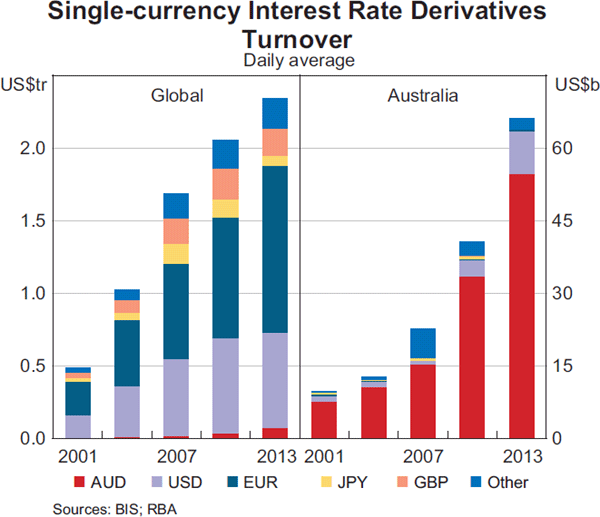
OTC Derivatives Outstanding
In addition to measuring turnover in OTC derivatives markets, the Triennial Survey provides information on the aggregate outstanding positions in these markets. This part of the survey – which was conducted to reflect outstanding positions as at the end of June 2013 – measures the size of the market.[15] Outstanding positions can be measured in several ways.[16] The most common is the notional amounts, which represent the reference amounts used to calculate payments made on derivatives contracts. By this measure, the size of the OTC derivatives market has grown substantially since 2001, both globally and domestically (Graph 8). The strong pace of growth in the Australian market has continued since 2010, with the notional amount of outstanding positions increasing by around 50 per cent, whereas the global market grew by approximately 20 per cent over this period.
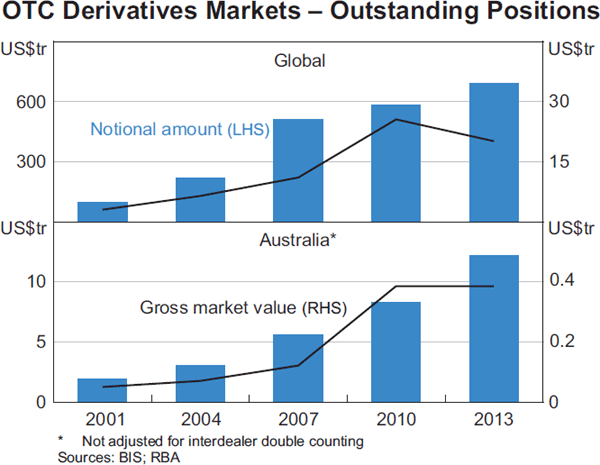
An alternative measure of the size of the derivatives market is the gross market value of outstanding positions, which measures the current replacement cost of a contract; that is, the gross cost to which a counterparty would be exposed if the open contracts were to be replaced. Gross market values are sensitive to changes in the underlying reference variable (i.e. the market price or interest rate), and therefore reflect both the quantity of derivatives contracts outstanding as well as observed fluctuations in market prices. In contrast to the increase in the notional amount of global OTC derivatives contracts, the gross market value of these instruments declined over the three years to June 2013. The gross market value of the Australian market was little changed at the equivalent of US$400 billion over this period, or around 2 per cent of global gross market value.
Much of the notional amounts outstanding and gross market values reflect the build-up of offsetting positions between counterparties. As such, these metrics are more useful indications of total activity in the market, rather than precisely measuring the build-up of risk. The decline in the gross market value of the global market over the past three years may in part reflect a reduction in offsetting positions, without affecting the net value of exposures. In particular, the increased focus on operational and counterparty risk management since the global financial crisis has encouraged greater use of trade compression services, which support the early termination of economically redundant derivatives positions.[17] For Australian institutions, the extent of trade compression may be limited by the one-directional nature of their foreign exchange contracts – reflecting their hedging of the currency risk on foreign borrowing. This would tend to reduce the incidence of redundant trades that can be terminated.
Single-currency interest rate derivatives account for the vast majority of outstanding OTC derivatives contracts globally (Table 4). These instruments are also prominent in the Australian market, although foreign exchange derivatives comprise a considerable share of the domestic market.[18] This partly reflects Australian banks' use of foreign exchange instruments to hedge the currency risk on their foreign borrowings (discussed above).[19]
| Share of notional principal outstanding | ||
|---|---|---|
| Global | Australia | |
| Single-currency interest rate | 83 | 65 |
| Foreign exchange | 12 | 33 |
| Credit | 4 | 1 |
| Equity | 1 | 0 |
| Commodity | 0 | 1 |
|
(a) Values of 0 indicate a share of total outstanding less than 0.5 per cent Sources: BIS; RBA |
||
Commodity, credit and equity derivatives represent a much smaller share of the OTC derivatives market, both globally and in Australia. Of these instruments, commodities derivatives are more prominent in Australia than they are globally, consistent with Australia's role as a key commodity producer.
Single-currency interest rate OTC derivatives
Globally, there was a 20 per cent increase in the notional amount of single-currency interest rate derivatives outstanding to US$577 trillion over the three years to June 2013, largely reflecting an increase in the notional amounts of euro-denominated contracts (Graph 9). In the Australian market, the notional amount of single-currency interest rate derivatives rose by 42 per cent over this period, while the gross market value declined.
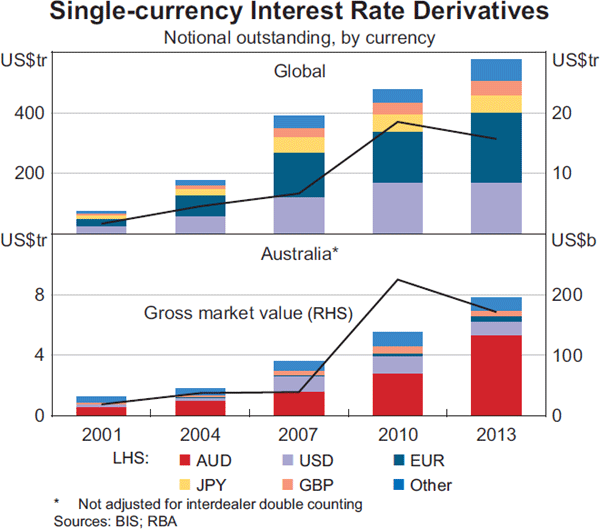
The bulk of positions in interest rate derivatives are held by reporting dealers – typically banks – and other financial institutions; this partly reflects the use of these instruments by intermediaries to hedge the interest rate risk on their balance sheets.
Non-financial counterparties accounted for only about 5 per cent of notional amounts outstanding in both the global and local markets (Graph 10). In Australia, the share of the market accounted for by non-financial institutions has declined considerably since 2001.
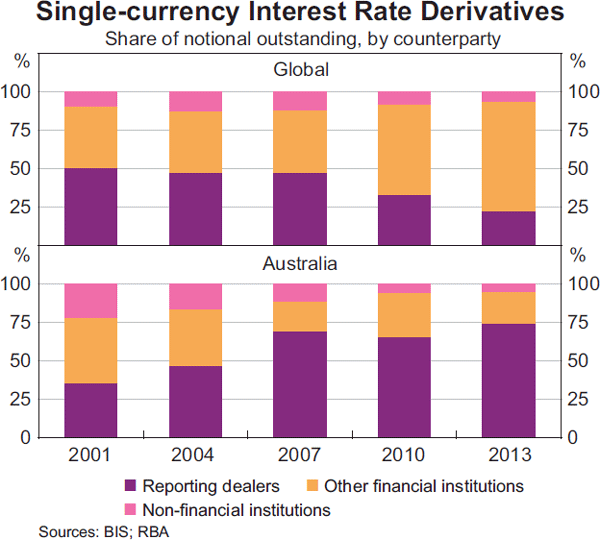
Foreign exchange OTC derivatives
The notional amounts of global foreign exchange OTC derivatives increased by 29 per cent over the three years to June 2013, whereas the gross market value declined (Graph 11); this may partly reflect the more subdued trading conditions for the currencies referenced in the majority of foreign exchange OTC derivatives contracts – the US dollar and the euro – compared with three years ago. The Australian market grew strongly over this period, with notional amounts and the gross market value increasing by 60 per cent and 40 per cent, respectively.
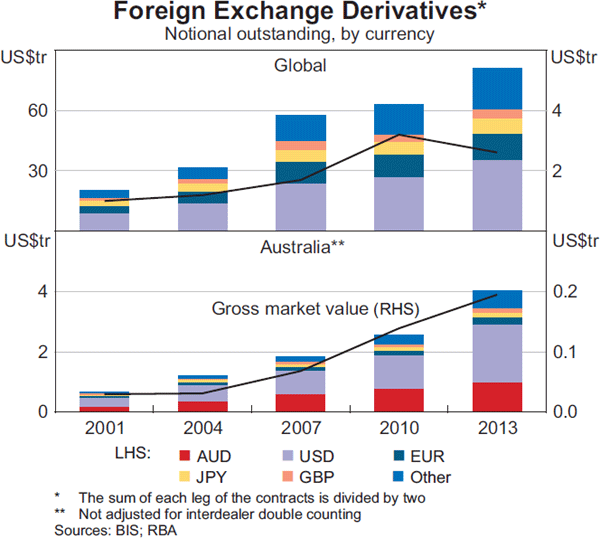
Globally, the currency composition of outstanding foreign exchange OTC derivatives has remained little changed since June 2007. For the Australian market, however, there has been a noticeable rise in the share of foreign exchange derivatives contracts involving a US dollar leg. In addition, the share of positions involving an Asian currency has increased since 2007. In particular, the notional amounts of contracts referencing the Hong Kong dollar and Singapore dollar have risen considerably over the past six years.
The residual maturity of foreign exchange derivatives contracts is generally shorter than that of other derivatives instruments, with most contracts maturing in one year or less (Graph 12). Compared with global foreign exchange derivatives positions, the Australian market is characterised by a greater share of contracts with maturities of more than one year; this partly reflects the use of longer-dated instruments to hedge the currency risk associated with Australian banks' offshore funding. The past three years have seen a decline in the share of instruments with a maturity of greater than five years – both domestically and globally – although in Australia's case the current share of these longer-dated instruments remains well above its level in the early 2000s.
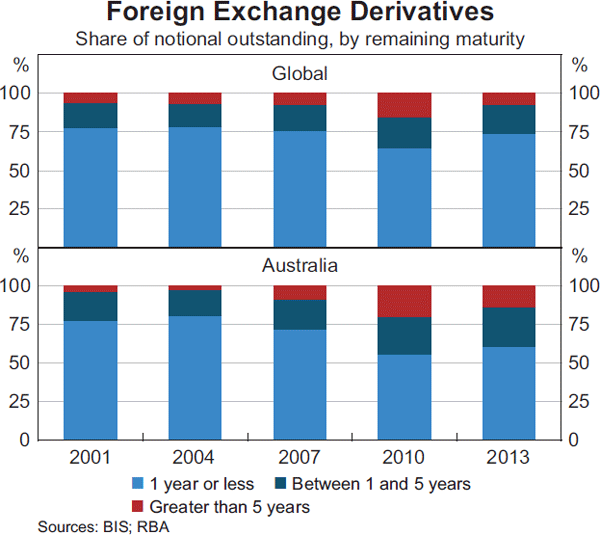
Credit default swaps
The notional amount of credit default swaps (CDS) outstanding increased by 20 per cent in the Australian market over the three years to June 2013, whereas the gross market value increased by 55 per cent. However, the Australian market remains small, with the notional amount outstanding equivalent to around 10 per cent of Australian GDP. By comparison, the notional amount of CDS outstanding globally is equivalent to 35 per cent of world GDP. The recent growth in the Australian market has been driven by contracts that reference more than one institution, which is consistent with the recent increase in the liquidity in these hedging instruments in Australia.
The notional amount of global CDS outstanding rose markedly leading up to the global financial crisis, from US$6 trillion in 2004 to US$45 trillion in June 2007 (Graph 13). The rapid expansion of the notional amount of CDS reflected, in part, the strong growth in underlying demand for these instruments. But this growth was also supported by the common practice among market participants of reducing an exposure by creating an offsetting position, rather than by closing the existing contract (IOSCO 2012). Since 2007, it has become increasingly common for dealers to engage in portfolio compression, by replacing mostly offsetting contracts with a contract of smaller notional value and, as a result, the notional amount of global CDS outstanding has declined noticeably.[20]
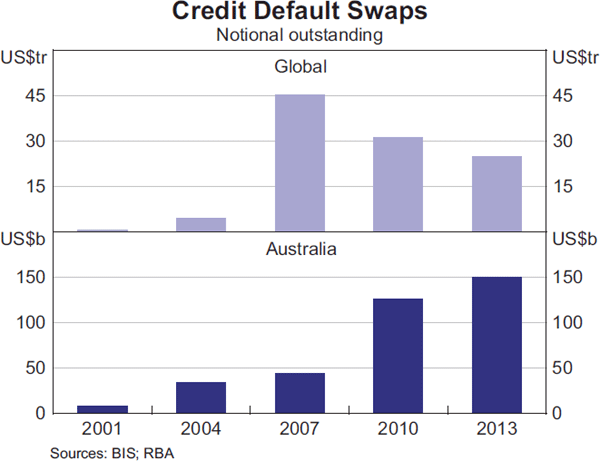
Conclusion
Turnover in global foreign exchange and OTC derivatives markets continued to increase over the three years to April 2013. While the increase coincided with growth in international trade, both cross-border lending and investment flows were little changed over the period. The growth in global turnover in foreign exchange markets appears to have partly reflected an increase in short-term trading activity, particularly in response to the policy announcement by the BoJ, which occurred early in the month of the 2013 survey. Globally, growth in foreign exchange turnover was most noticeable in the United Kingdom, and between reporting dealers and other financial institutions. In contrast, foreign exchange turnover in the Australian market declined slightly over the three-year period, despite a marked increase in trading of the Australian dollar globally. The notional amount of outstanding OTC foreign exchange and interest rate derivatives contracts grew strongly over the three years to the end of June 2013, both globally and in the Australian market. However, the gross market value of global OTC derivatives declined over this period. This may partly reflect the more subdued trading conditions for the US dollar and the euro, which are the currencies referenced in the majority of OTC derivatives contracts.
Footnotes
The authors are from Financial Markets Group. [*]
The 2013 Triennial Survey was coordinated by the Bank for International Settlements (BIS). The turnover portion was conducted by central banks and other authorities across 53 jurisdictions while the outstandings portion covered 47 jurisdictions. [1]
For an analysis of the results of the 2013 Triennial Survey by the BIS, see BIS (2013). [2]
All data are expressed at current exchange rates. At constant exchange rates, global turnover also increased by 35 per cent over the three years to April 2013. [3]
‘Reporting dealers’ include commercial and investment banks, securities houses and other entities that actively participate in the foreign exchange market and submit data to the survey. [4]
At constant exchange rates, turnover in the Australian market fell by 16 per cent. Unless otherwise stated, global turnover figures are adjusted for interdealer double counting at both the local and global level. Country subtotals are adjusted for interdealer double counting at the local level only. [5]
Semiannual surveys are conducted by central banks and other authorities in Australia, Canada, Japan, Singapore, the United Kingdom and the United States. These centres now account for around 75 per cent of the global foreign exchange market. However, the results are not directly comparable to the Triennial Survey due to some differences in the collection and attribution of turnover. Australia's results for the semiannual survey are available on the Australian Foreign Exchange Committee website at <http://www.rba.gov.au/afxc/statistics/fx-turnover-reports/>. Quarterly data for the Australian market are also available at <http://www.rba.gov.au/statistics/tables/> (Tables F9 and F10). [6]
For a detailed discussion on developments in the internationalisation of the renminbi, see Ballantyne, Garner and Wright (2013). [7]
Some of the decline in turnover between reporting dealers and other financial institutions in the Australian market could be attributable to the effect of reclassification, as some previously non-reporting banks were reclassified as reporting dealers for the 2013 survey. Reclassifications could also affect the interpretation of the global results. [8]
Market makers provide liquidity to the foreign exchange market through the continuous quoting of prices to buy or sell foreign currency and committing to take the opposite side of customer transactions. For a discussion on high-frequency trading in the foreign exchange market, see BIS Markets Committee (2011). [9]
For more information on hedging behaviour in Australia, see Rush, Sadeghian and Wright (2013). [10]
For more information on developments in technology and the foreign exchange market, see Heath and Whitelaw (2011). [11]
Some entities hedge a portion or all of the foreign exchange risk that arises from holding assets and liabilities denominated in a foreign currency. This can generate ongoing demand for foreign exchange derivatives, particularly foreign exchange swaps and forwards, as hedge positions are set up and then maintained. [12]
For more information on Australian bank funding, see Robertson and Rush (2013). [13]
Single-currency interest rate derivatives include forward rate agreements, swaps and options. [14]
The survey on turnover covers 25 reporting dealers in the Australian market while the survey of outstandings covers six major Australian banks. [15]
See ‘Box A: Understanding the Three Measures of Market Size’ in Ahn, Matić and Vallence (2012) for a more detailed explanation. [16]
Otherwise known as ‘tear-ups’, the process involves matching similar derivatives contracts and replacing those with contracts of a smaller notional value, without changing the overall risk profile of each position. [17]
Foreign exchange derivatives are defined broadly in the Triennial Survey and include cross-currency basis swaps, FX swaps, forward contracts and currency options. [18]
For further information on Australian banks' use of foreign exchange instruments to hedge the currency risk on their foreign borrowings, see Arsov et al (2013) and Rush et al (2013). [19]
See Fabbro (2011) for more information on global CDS outstanding. [20]
References
Ahn J, M Matić and C Vallence (2012), ‘Australian OTC Derivatives Markets: Insights from the BIS Semiannual Survey’, RBA Bulletin, December, p 42.
Arsov A, G Moran, B Shanahan and K Stacey (2013), ‘OTC Derivatives Reforms and the Australian Cross-currency Swap Market’, RBA Bulletin, June, pp 55–63.
Ballantyne A, M Garner and M Wright (2013), ‘Developments in Renminbi Internationalisation’, RBA Bulletin, June, pp 65–74.
BIS (Bank for International Settlements) (2013), BIS Quarterly Review, December, pp 27–82.
BIS Markets Committee (2011), ‘High-frequency Trading in the Foreign Exchange Market’, Markets Committee Publications No 5.
Fabbro D (2011), ‘The Australian Credit Default Swap Market’, RBA Bulletin, December, pp 57–66.
Heath A and J Whitelaw (2011), ‘Electronic Trading and the Australian Foreign Exchange Market’, RBA Bulletin, June, pp 41–48.
IOSCO (International Organization of Securities Commissions) (2012), ‘The Credit Default Swap Market’, June. Available at <http://www.iosco.org/library/pubdocs/pdf/IOSCOPD385.pdf>.
Robertson B and A Rush (2013), ‘Developments in Banks' Funding Costs and Lending Rates’, RBA Bulletin, March, pp 63–70.
Rush A, D Sadeghian and M Wright (2013), ‘Foreign Currency Exposure and Hedging in Australia’, RBA Bulletin, December, pp 49–57.